We don’t know how buckwheat became a health trend, but we’re all for it!
Which is healthier...the brown or the green variety? What are the healthiest ways to eat buckwheat and what benefits does it give?
Here’s the full guide:
Buckwheat crepes, buckwheat bread, buckwheat granola - it seems that this health trend isn’t going anywhere. On the contrary, we are seeing more and more creative uses for this wonder ingredient. So what's the story behind buckwheat? What are its health benefits? And, how do you eat it? Here are the answers.
Although most of us consider it as part of the cereal family, it’s not. The buckwheat grains we eat are actually the seeds of a plant from the cranberry family, and botanically it’s not a grain at all.
Buckwheat has many health benefits. It has a low glycemic value as compared to grains, is rich in antioxidants, quality protein and dietary fiber, is a source of minerals such as zinc, iron, selenium, magnesium and various B vitamins. In addition, consumption of buckwheat has been found to help lower cholesterol and balance sugar levels.
Is buckwheat (Hebrew: kosemet) like spelt (Hebrew: koosmin)?
If you’re confused between buckwheat and spelt, you’re not alone. Although the names and uses are similar, they are two completely different animals.Spelt is an ancient grain, a relative of wheat, and so, an essential difference between the two is that unlike spelt, buckwheat doesn't contain gluten and is safe to use for those who are sensitive to gluten and people with celiac.Roasted or not roasted?There are two types of buckwheat available: brown buckwheat (roasted) and green buckwheat (unroasted).
Roasted buckwheat is especially suitable for cooking as a side dish similar to rice, and has a stronger flavor and aroma than unroasted. Green buckwheat has a more delicate taste, and because it’s unroasted, is even more nutritious, since processing damages some nutrients. Green buckwheat stars mostly in recipes like bread, crepes and tortillas. You are warned: Trying to prepare these dishes with roasted buckwheat won’t work.So, what do you do with buckwheat?There are countless ways to incorporate this wonderful dish into your daily menu.Cooking: To cook roasted buckwheat, add one cup of buckwheat and two cups of water to a pot (it’s recommended to rinse the buckwheat in a colander before cooking), bring to a boil, lower the heat and cook with the pot covered for 15 to 20 minutes. You can lightly fry the buckwheat in olive oil before adding the water that will improve the texture and help separate the grains. When the buckwheat is ready, eat it as a hot side dish, add to stews, or as a cold addition to salads (like quinoa). Cook green buckwheat the same way.Bread, crepes and tortillas: There are countless recipes for buckwheat breads, crepes and tortillas online. The recipes usually require soaking the buckwheat for several hours and grinding with water that forms a batter. The result: Satisfying, gluten-free baked goods with a particularly rich texture and flavor.To make a buckwheat tortilla, soak two cups of green buckwheat in water overnight or for several hours. In the morning, strain the buckwheat, and place in a food processor along with 2 cups of water and a pinch of salt. Grind the buckwheat and water until a smooth batter is formed (the batter will look like tahini). Spread the batter in an even circle on a non-stick pan, or on a pan lightly greased with olive oil, cook 2 minutes or until the tortilla can be easily flipped, turn, 2 more minutes, transfer to a plate, fill with your favorite fillings (cheese, tomato paste) and roll.
Freeze extra tortillas, heat as needed.
Flour: Buckwheat flour is a wonderful and nutritious substitute for those who avoid gluten or for those who are looking for some variety in the kitchen. Make it yourself by grinding green buckwheat to a powdery texture in a food processor or buy it ready-made. Be aware that in most cases buckwheat flour can’t be used in place of wheat flour, so look for recipes designed for using buckwheat flour.
Buckwheat noodles (soba): Traditional Japanese noodles made from buckwheat. Cook them in water, just like pasta, and they can be added cold to salads or hot to stir-fries or soups.
Buckwheat pasta: much more of a substitute for those looking for gluten-free pasta. Buckwheat pasta will contain a higher amount of fiber and protein than most classic pastas, making it a more nutritious alternative.
Buckwheat crackers: Do you like the classic white rice cakes? Buckwheat rice cakes contain a higher amount of fiber and protein. They’ll make you feel full for a longer time.
